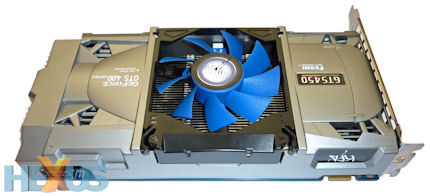Good blend of features and price
The GeForce GTS 450 1,024MB GPU was reviewed on Monday. We found its performance to be just a touch better than AMD's Radeon HD 5750, enabling NVIDIA to compete in the £100 graphics-card market with its new Fermi architecture.While stock-clocked cards will be released by all and sundry, what NVIDIA really wants you to do is to buy a GeForce GTS 450 that stretches the legs of the architecture. Clocking in at a decent 783MHz core, 1,566MHz shaders and 3,608MHz memory for the basic GPU, partners have been encouraged to put forward their own designs, heavily pre-overclocked, and to release them with a small premium over vanilla cards.
ASUS took this advice to the letter with its GeForce GTS 450 TOP, clocked in at an impressive 925MHz/4,000MHz. We noted that it used the same cooling employed on its custom-cooled GeForce GTX 460 cards and thought that other partners would follow suit.
Now a few days on, we take a look at the KFA2 GeForce GTS 450 1,024MB LTD OC offering. Never heard of the company before? Head right on over to here to learn more. We found its special edition GTX 460 cooled by a novel approach that was highlighted by a user-detachable fan.
KFA2 reckons its cooling is worthy of investment in another GeForce card, so it's grabbed the chunky cooler from the GTX 460 LTD OC and plonked it right on top of the GTS 450. The newer mid-range GeForce part pulls around 40W less than the GTX 460, meaning the double-height cooler will be more than up to the task of keeping the core cool.
Why change a winning design?
The 80mm fan can be removed from the card in about 10 seconds, presumably to aid cleaning and to aid airflow to the twin-heatpipe heatsink. While this is all fine and dandy - rather novel in fact - one cannot change the fan for a third-party model, which is a real missed opportunity in our opinion.
Being of the LTD OC ilk - read highly overclocked - this GTS 450 ships at 888MHz core (lucky for some, huh?), 1,766MHz shaders, and 4,000MHz memory. KFA's core speed is some way down on ASUS', hinting at more frequency to come from a bout of overclocking. KFA2 provides its Xtreme Tuner HD app by way of download if you want to push the card further.
A massive cooler seems overkill for a GPU that only requires a single six-pin PCIe connector, but as we saw in the ASUS review, overclocked and overvolted GeForce GTS 450s can chuck out a lot of heat. More so if you lash two together in SLI - via the connector on the right-hand edge of the PCB.
The angular looks are an acquired taste, though.
KFA2's connectivity options match ASUS', meaning VGA, dual-link DVI and a mini-HDMI port. KFA2 is thoughtful enough to throw in a mini-HDMI-to-HDMI adapter in the box. Again, we'd go with two dual-link DVI ports, plus mini-HDMI.
One area where KFA2 beats ASUS is with the quality of the memory specified. KFA2 uses 0.4ns-rated K4G10325FE-HC05 GDDR5 memory chips - four on the front and back - which are rated to a whopping 5,000MHz speed - a whole 1,000MHz higher than either the reference or ASUS card. Overclocking, then, should be fun.
Warranty-wise, KFA provides two-year cover underscored by a UK call centre for both technical and RMA enquiries. Seeing how the competition have moved on in this aspect, a three-year warranty would, of course, be preferable.
First-page verdict
KFA2's taken what it's learned from designing an aftermarket cooler for the potent GeForce GTX 460 and applied the knowledge to the GTS 450. The cooler's clearly over the top for a vanilla card, so the company cranks up the frequencies to 888MHz core and 4,000MHz memory.
Sweetening the deal considerably is a very competitive retail price of just over £100, putting it in the same bracket as garden-variety GTS 450s and the immediate competition from AMD, the Radeon HD 5750.















